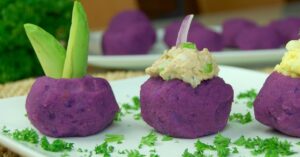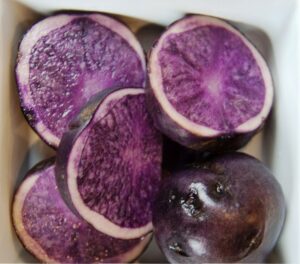

Living up to their royal hue and lineage, purple potatoes have long been considered the “food of gods,” and were reserved for Incan kings in Peru. They have been a staple of the Peruvian diet, but are relatively new in the United States. There are a variety of purple potatoes, but most commonly seen are small spuds the size of a walnut. Purple and yellow potatoes not only differ in color, but health benefits as well. To maximize health benefits, it is important to cook the potatoes with the skin intact because the skin contains a pigment called anthocyanin, a phytochemical packed with nutritious benefits.
Potatoes are very diverse and considered a nutritious New World food. In Peru alone, there are over 3,000 kinds of potatoes and when visiting local markets, there are countless potato varieties in an array of colors and shapes. Potatoes generally are very versatile and can be used in a variety of foods. The purple color of the potatoes brings more interest to more traditional foods and adds more nutritious benefits. These potatoes can be used to make stews, vegetable roasts, soups, or even a Nicoise salad.
With more than two times the antioxidant content of white or yellow ones, purple potatoes provide an array of essential nutrients, such as anthocyanins, that help us stay healthy. These compounds actively scavenge for free radicals found throughout the body. Anthocyanins are absorbed into the bloodstream, which has a healing effect on the liver and helps to control blood pressure. Additionally, the anthocyanins present in purple potatoes can help fight against oxidative stressors that can cause disease and have been linked with cancer prevention and reducing cancer cell growth. This phytochemical also supports brain health and cognitive function, which makes it an anti-aging power food.





